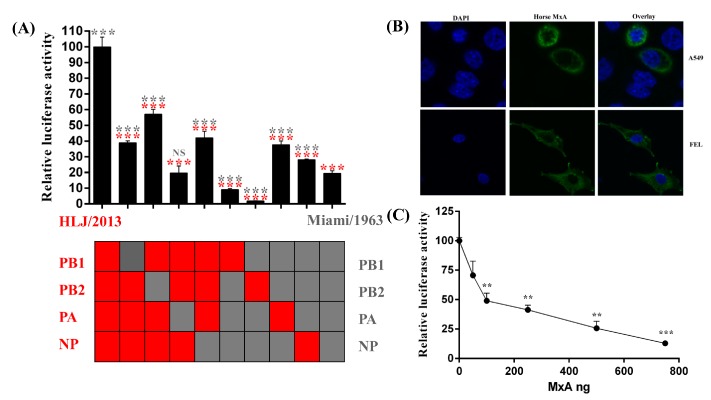Figure 5.
Investigation of EIV polymerase activity (A) or the antiviral properties of eqMxA against EIV (B,C) in FEL cells using our developed influenza virus polymerase reconstitution assay based on the horse PolI promoter. (A) Comparison of the polymerase activity of Miami/1963 and HLJ/2013. Each combination of plasmids expressing RNPs of Miami/1963 and HLJ/2013, together with pRL-TK and pLW500-NPluci, was co-transfected separately into FEL cells in 24-well plates. The transfection method and the amount of plasmids was the same as in Figure 2B. The relative luciferase activity associated with HLJ/2013 was set at 100%. Each experiment was repeated three times. The statistical significance of the comparisons between Miami/1963 or HLJ/2013 and other combinations was marked by gray or red, respectively (***, p < 0.001; NS, not significant); (B) the subcellular location of eqMxA protein with an N-terminal Flag tag in A549 and FEL cells. The pCAGGs-eqMxA plasmid was transfected into A549 or FEL cells. At 24 h after transfection, cells were fixed with 4% paraformaldehyde and permeabilized by 0.25% Triton X-100. After blocking with 5% non-fat milk in PBS, the cell samples were incubated with anti-flag monoclonal antibody (Sigma, St. Louis, MO, USA) and then detected by IFKine Green conjugated goat anti-mouse polyclonal antibody (Abbkine, Redlands, CA, USA). Nuclear DNA was labeled with DAPI solution (Beyotime, Beijing, China); and (C) identification of the influence of eqMxA protein on influenza virus polymerase activity by influenza virus polymerase reconstitution assay. The pCAGGs-HLJ PB1 (50 ng), PB2 (50 ng), PA (50 ng), NP (100 ng), pRL-TK (10 ng), and pLW500-NPluci (100 ng) constructs, with a total amount of 750 ng of pCAGGs-eqMxA and a blank vector of pCAGGs (increasing amounts of 0 ng, 50 ng, 100 ng, 250 ng, 500 ng, and 750 ng of pCAGGs-eqMxA), were co-transfected into FEL cells in 48-well plates. At 24 h after transfection, relative luciferase activity was measured by the dual-luciferase assay. The relative luciferase activity subjected to 0 ng of pCAGGs-eqMxA was set as 100%. Each experiment was repeated three times. Statistical significance was compared with the result of the 0 ng pCAGGs-eqMxA group (**, p < 0.01; ***, p < 0.001).

